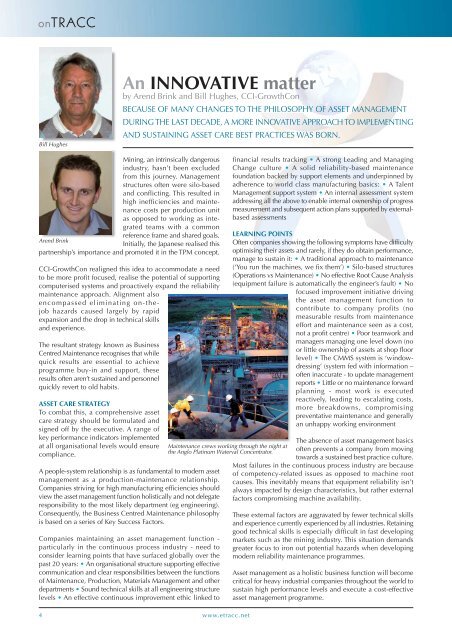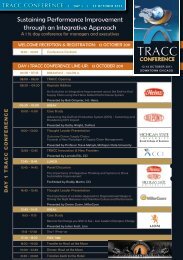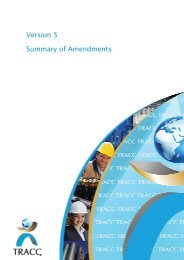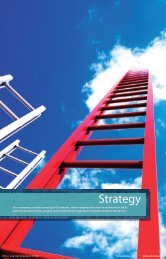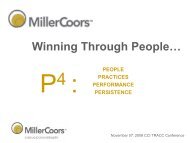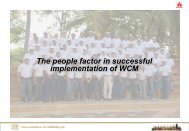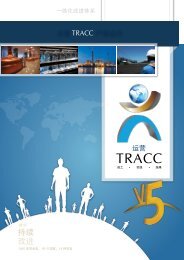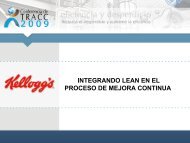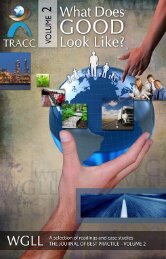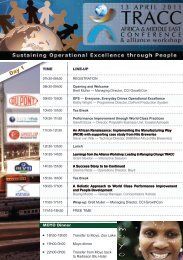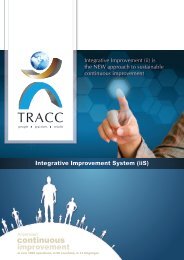WINNING formula - WGLL - TRACC
WINNING formula - WGLL - TRACC
WINNING formula - WGLL - TRACC
Create successful ePaper yourself
Turn your PDF publications into a flip-book with our unique Google optimized e-Paper software.
Bill Hughes<br />
An INNOVATIVE matter<br />
by Arend Brink and Bill Hughes, CCI-GrowthCon<br />
BECAUSE OF MANY CHANGES TO THE PHILOSOPHY OF ASSET MANAGEMENT<br />
DURING THE LAST DECADE, A MORE INNOVATIVE APPROACH TO IMPLEMENTING<br />
AND SUSTAINING ASSET CARE BEST PRACTICES WAS BORN.<br />
Mining, an intrinsically dangerous<br />
industry, hasn’t been excluded<br />
from this journey. Management<br />
structures often were silo-based<br />
and conflicting. This resulted in<br />
high inefficiencies and maintenance<br />
costs per production unit<br />
as opposed to working as integrated<br />
teams with a common<br />
reference frame and shared goals.<br />
Arend Brink<br />
Initially, the Japanese realised this<br />
partnership’s importance and promoted it in the TPM concept.<br />
CCI-GrowthCon realigned this idea to accommodate a need<br />
to be more profit focused, realise the potential of supporting<br />
computerised systems and proactively expand the reliability<br />
maintenance approach. Alignment also<br />
encompassed eliminating on-thejob<br />
hazards caused largely by rapid<br />
expansion and the drop in technical skills<br />
and experience.<br />
The resultant strategy known as Business<br />
Centred Maintenance recognises that while<br />
quick results are essential to achieve<br />
programme buy-in and support, these<br />
results often aren’t sustained and personnel<br />
quickly revert to old habits.<br />
ASSET CARE STRATEGY<br />
To combat this, a comprehensive asset<br />
care strategy should be <strong>formula</strong>ted and<br />
signed off by the executive. A range of<br />
key performance indicators implemented<br />
at all organisational levels would ensure<br />
compliance.<br />
A people-system relationship is as fundamental to modern asset<br />
management as a production-maintenance relationship.<br />
Companies striving for high manufacturing efficiencies should<br />
view the asset management function holistically and not delegate<br />
responsibility to the most likely department (eg engineering).<br />
Consequently, the Business Centred Maintenance philosophy<br />
is based on a series of Key Success Factors.<br />
Companies maintaining an asset management function -<br />
particularly in the continuous process industry - need to<br />
consider learning points that have surfaced globally over the<br />
past 20 years: • An organisational structure supporting effective<br />
communication and clear responsibilities between the functions<br />
of Maintenance, Production, Materials Management and other<br />
departments • Sound technical skills at all engineering structure<br />
levels • An effective continuous improvement ethic linked to<br />
Maintenance crews working through the night at<br />
the Anglo Platinum Waterval Concentrator.<br />
financial results tracking • A strong Leading and Managing<br />
Change culture • A solid reliability-based maintenance<br />
foundation backed by support elements and underpinned by<br />
adherence to world class manufacturing basics: • A Talent<br />
Management support system • An internal assessment system<br />
addressing all the above to enable internal ownership of progress<br />
measurement and subsequent action plans supported by externalbased<br />
assessments<br />
LEARNING POINTS<br />
Often companies showing the following symptoms have difficulty<br />
optimising their assets and rarely, if they do obtain performance,<br />
manage to sustain it: • A traditional approach to maintenance<br />
(‘You run the machines, we fix them’) • Silo-based structures<br />
(Operations vs Maintenance) • No effective Root Cause Analysis<br />
(equipment failure is automatically the engineer’s fault) • No<br />
focused improvement initiative driving<br />
the asset management function to<br />
contribute to company profits (no<br />
measurable results from maintenance<br />
effort and maintenance seen as a cost,<br />
not a profit centre) • Poor teamwork and<br />
managers managing one level down (no<br />
or little ownership of assets at shop floor<br />
level) • The CMMS system is ‘windowdressing’<br />
(system fed with information –<br />
often inaccurate - to update management<br />
reports • Little or no maintenance forward<br />
planning - most work is executed<br />
reactively, leading to escalating costs,<br />
more breakdowns, compromising<br />
preventative maintenance and generally<br />
an unhappy working environment<br />
The absence of asset management basics<br />
often prevents a company from moving<br />
towards a sustained best practice culture.<br />
Most failures in the continuous process industry are because<br />
of competency-related issues as opposed to machine root<br />
causes. This inevitably means that equipment reliability isn’t<br />
always impacted by design characteristics, but rather external<br />
factors compromising machine availability.<br />
These external factors are aggravated by fewer technical skills<br />
and experience currently experienced by all industries. Retaining<br />
good technical skills is especially difficult in fast developing<br />
markets such as the mining industry. This situation demands<br />
greater focus to iron out potential hazards when developing<br />
modern reliability maintenance programmes.<br />
Asset management as a holistic business function will become<br />
critical for heavy industrial companies throughout the world to<br />
sustain high performance levels and execute a cost-effective<br />
asset management programme.<br />
4<br />
www.etracc.net


